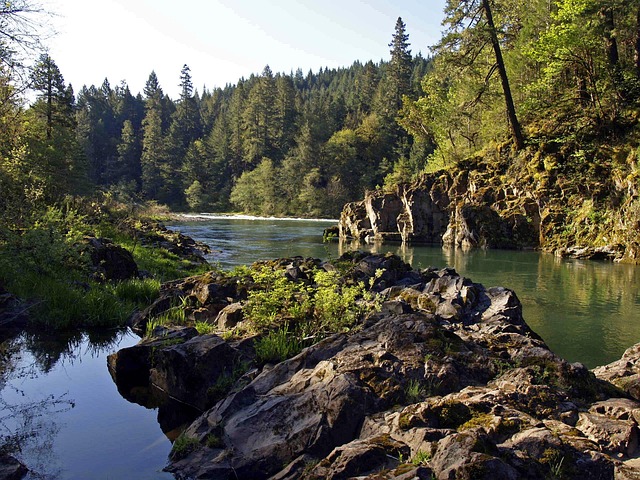In the 19th century, thousands of early settlers navigated the untamed wilderness of Lane County, Oregon, along the historic Oregon Trail, seeking free land and fertile soil. They braved dense forests, rugged terrain, and hostile tribes to build sturdy pioneer cabins, establish homesteads, and forge thriving communities. Despite challenges, their resilience shaped the region into a vibrant agricultural hub, leaving an indelible legacy on Lane County's landscape and history.
“Uncover the captivating stories of Lane County, Oregon’s pioneering families, who shaped the region’s history. From the early settlers who dared to venture into uncharted territories to the trials and triumphs of homesteading, this article delves into the daily lives and struggles of these trailblazers.
Explore the rugged landscapes where sturdy cabins stood, witness the growth of vibrant communities, and understand how the Oregon Trail forever etched its path in Lane County’s pioneer heritage. Discover the resilience and determination that defined these remarkable families.”
- Early Settlers in Lane County: A Glimpse into the Past
- Homesteading in Oregon: The Challenges and Triumphs of Lane County Pioneers
- Pioneer Life in Lane County: Cabins, Communities, and Daily Struggles
- The Oregon Trail's Impact: How It Shaped Lane County's Pioneer Families
Early Settlers in Lane County: A Glimpse into the Past

Lane County, Oregon, boasts a rich history marked by the resilience and determination of its early settlers. The 19th century saw an influx of pioneers who ventured into this untamed landscape, drawn by the promise of fertile land and new opportunities. These settlers played a pivotal role in transforming the wilderness into thriving communities, each with their unique stories and contributions.
The journey was not without challenges. Homesteading in Lane County demanded unwavering perseverance as families navigated dense forests, rugged terrain, and the ever-present threat of danger from wildlife and hostile tribes. Despite these obstacles, they built sturdy cabins, cleared land for farming, and established vital trading routes, including those along the Oregon Trail. Their stories are a testament to human ingenuity and the unyielding spirit that defines pioneer life in Oregon.
Homesteading in Oregon: The Challenges and Triumphs of Lane County Pioneers

In the 19th century, the allure of untamed lands drew many to Lane County, Oregon, where the promise of free land and fertile soil enticed early settlers from across the nation. Homesteading became a way of life for these pioneers who ventured along the Oregon Trail, seeking new opportunities and a chance to build a better future. Life in Lane County was characterized by resilience and determination as families navigated the challenges of establishing their homes in a remote, wilderness-like setting. They braved harsh winters, cleared land for farming, and built sturdy cabins that became sanctuaries against the elements.
Despite the hardships, the pioneer spirit thrived in these early settlers. They forged communities, established schools, and created churches, transforming Lane County into a thriving agricultural hub. The journey was not without its trials, with frequent conflicts over land claims and resource scarcity adding to the difficulties of pioneer life in Oregon. Yet, through perseverance and a deep-rooted sense of community, they left an indelible mark on the landscape, shaping the rich history that still echoes through the valleys and forests of Lane County.
Pioneer Life in Lane County: Cabins, Communities, and Daily Struggles

The early settlers of Lane County, Oregon, embarked on a challenging yet rewarding journey as they navigated the untamed wilderness that would become their new home. Life for these pioneers was centered around the concept of homesteading, where they claimed and developed plots of land, often in remote areas. The county’s rugged terrain and diverse landscapes, ranging from forests to fertile valleys, presented both opportunities and obstacles for these determined individuals.
Lane County pioneer cabins were modest structures, providing shelter and a sense of community among the close-knit settlers. Daily life involved hard work, as they tilled the soil, raised livestock, and foraged for resources. The Oregon Trail, a historic migration route, passed through the county, connecting these isolated communities with the outside world. Despite the struggles, the pioneers’ resilience and determination left an indelible mark on the region’s history, shaping the vibrant communities that flourish in Lane County today.
The Oregon Trail's Impact: How It Shaped Lane County's Pioneer Families

The Oregon Trail, a historic route that stretched for over 2,000 miles, played a pivotal role in shaping Lane County’s pioneer families. As early settlers ventured west, they encountered an arduous journey along this trail, which became a lifeline connecting them to new opportunities and a promising future. The impact of the Oregon Trail on Lane County is evident in the resilience and determination of its pioneers who, despite numerous challenges, succeeded in homesteading vast stretches of land, building sturdy cabins, and establishing thriving communities.
The trail’s influence permeated every aspect of pioneer life in Lane County. Settlers encountered a diverse landscape, navigating through dense forests, towering mountains, and the rugged terrain that characterized the region. They faced harsh weather conditions, food shortages, and health hazards, all while toiling day and night to clear land for farming and establish self-sufficient households. The Oregon Trail not only tested their physical endurance but also forged unbreakable bonds among fellow travelers, as they relied on one another for support, trade, and companionship during this arduous journey.
